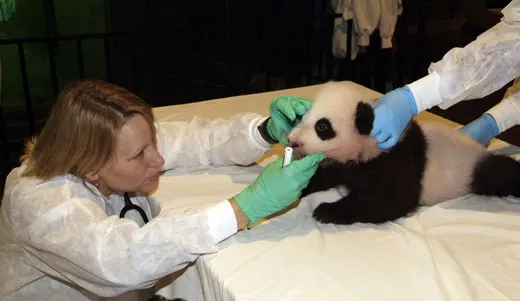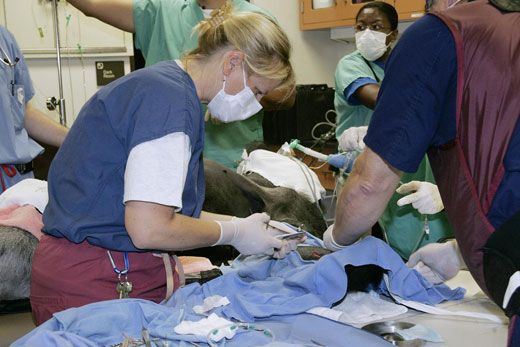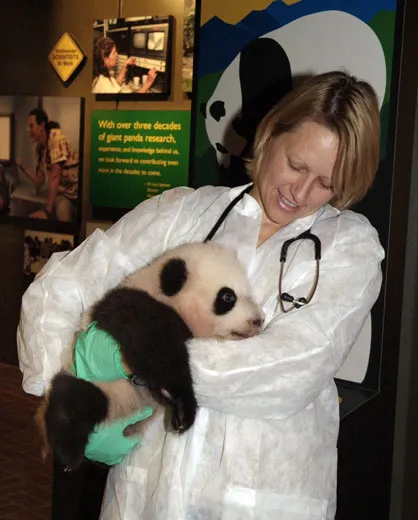On the Job: Zoo Veterinarian
Suzan Murray talks about making house calls at the nation’s zoo
/https://tf-cmsv2-smithsonianmag-media.s3.amazonaws.com/filer/onthejob-zoo-631.jpg)
Suzan Murray, chief veterinarian at the Smithsonian's National Zoo in Washington, D.C., oversees the health care of 2,000 animals from some 400 species. On a recent spring morning's rounds, she checked on an artificially-inseminated elephant, a giant anteater with skin abrasions, a kiwi named Manaia and an anesthetized Burmese python. Murray discusses what it takes to become a vet and what it's like making house calls at the nation's zoo.
What made you decide to become a zoo veterinarian?
As a kid, I liked animals, and I was good at math and sciences. We had a lot of animals around the house, and my grandparents had a farm. Those were some of the things that made me realize that [veterinary medicine] was something I was interested in pursuing.
What skills and training are required for your position?
After college and four years of veterinary school, typically you do a one-year internship and then a three-year residency. A residency is a period in which you specialize in a particular area of medicine. So in human medicine, you can have cardiology, urology, dermatology. Veterinary medicine has a number of those same specialties, one of which is zoological medicine. The National Zoo runs one of the few zoological medicine residency programs in the country. I actually did my training here years ago. After that, you can do something to become a specialist and become board certified in zoo medicine. In order to run a training program, you need to be board certified, to be a specialist in zoo medicine.
How does the National Zoo differ from other zoos?
One of the great things about the Smithsonian is all of our different resources and levels of expertise. Not every zoo has a pathologist, or nutritionist or the level of keeper training that this zoo has. The standard of animal care that we provide is excellent, so I think that, along with the ability to contribute to science and conservation, is what really sets us apart. We use what we learn to take care of animals here and to learn how to manage animals in the wild.
We have a lot of conservation programs where we use information from the wild to help manage animals here. We have a project in Kenya looking at kori bustards, the largest flighted bird. In captivity, we found that they have a high instance of liver disease, of hemochromatosis, which is the storing of iron in the liver. We studied what they're eating in the wild, collected blood samples, analyzed that for iron and then compared to what we do in captivity. We learned that they're not eating much meat in the wild. They're eating more berries and insects. That helped us modify the diet to keep them healthier in captivity.
How many veterinarians work at the zoo?
We have myself and two clinical vets downtown as well as two residents, and then the head vet at the Conservation and Research Center [in Virginia], Luis Padilla.
How closely do you and the other vets work with the zoo's animal keepers?
As head of the department, I don't have as much direct animal care as I used to or as I would like. The veterinarians that do the clinical care get a lot of interaction with the keepers, who are really our eyes and ears. They're the ones that know the animals. They're the ones that can tell when something's wrong. We depend on each other a lot.
What is an average day like?
There really is no average day. We start out with rounds early in the morning, and then we have our duties divided. There's someone who does our park checks and there's someone who stays behind and does the clinical work. The animals we work on really vary—from a fish to an elephant to a bird to a reptile—so every day is going to be a little different.
What was your most exciting moment on the job?
Working as a veterinarian at the National Zoo, there is an exciting moment every single day. Each one is a little bit different, whether it's coming up with a treatment for coral, diagnosing a problem in a Burmese python, or visiting an elephant we're hoping is pregnant. There's really no way to compare. Every day offers a bounty of surprises.
What is the biggest misconception about the work that you do?
I don't know that there are misconceptions about our work. Most people that meet us—the zoo vets—say, "Wow! You have a fabulous job!" And that's pretty perceptive. People are always happy to hear about how far we go for animal care and how much we do for the individual animal. I think people are always really pleasantly surprised to hear about the varying levels of expertise here at the zoo, whether it's the keepers, the reproductive physiologists, the pathologists, the nutritionists. There are so many different layers of animal care that might not be obvious to the casual observer.
What advice do you have for someone who wants to go into this field?
I have a lot of conversations with youngsters who want to be veterinarians, and what I tell them is to follow their passion and their interests. If a student is really interested in veterinarian medicine, he or she should stick with it. Every road has its twists and turns. Just keep aiming in your direction, correct when you're off course and don't take "no" for an answer. Keep going.


